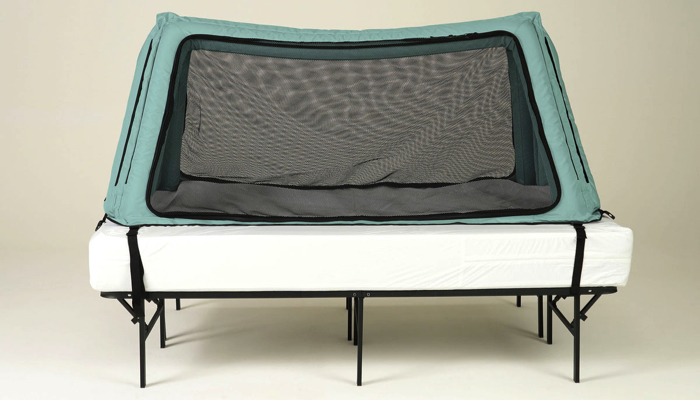When Do Toddlers Stop Napping?

- Toddlers begin reducing their naps around 18 months, and most kids drop their naps entirely by the age of five.
- Dropping naps is a process that takes time, and you do not have to eliminate naps cold turkey.
- Nap time can be replaced with quiet time so your child still rests and relaxes even though they’re no longer falling asleep.
Wondering if your toddler is ready to drop their daytime naps? Some kids love their naps and are still taking them at age four or five. Other kids are ready to drop the sleep and keep powering through the day at two and a half or three.
Nap time can be great for parents and caregivers. It’s a chance to take a break, get chores done, relax with a coffee, or read or work uninterrupted for an hour or two. You may be tempted to keep the naps going as long as possible because you also love that break in the day.
However, nap time does come to an end for all toddlers eventually. So how do you know when your child is ready? As with most things, our kids show us they’re ready for a transition better than any parenting book could predict.
Still, there are some signs that can help you figure out when toddlers stop napping and ways to help them through the transition.
When Should Toddlers Stop Napping?
There are no rules on the exact age at which your toddler should stop napping. Kids stop napping gradually and at their own pace. Each person’s need for sleep is different. More important than your child’s age are the signs that they are ready to stop napping.
Daytime naps are important for your child’s growth and development. According to the American Academy of Sleep Medicine, children ages one to two need about 11 to 14 hours of sleep. Children ages three to five need about 10 to 13 hours of sleep per day, including naps.
When it comes to dropping daytime sleep, UC Davis Health reports that most children under two take two naps per day. After age two, many children drop to one daily nap.
Most toddlers then stop napping altogether by about the age of five. However, some children may drop their nap earlier, starting around age three.
Whatever your child’s age, you shouldn’t feel pressured to end their naps cold turkey if it’s clear that they still need nap time.

How to Tell That Your Toddler Still Needs to Nap
As your child gets older, they may start resisting nap time or having difficulty falling asleep at their usual routine time. They might struggle to sleep, get frustrated, and fight nap time. You may be wondering if this means they’re ready to stop napping.
While resistance to naps can be a sign that the time for dropping naps completely is coming, it’s important to notice how your child reacts to skipping naps to judge whether they’re really ready for the change.
Look for these signs that your child may still need their nap, even if they don’t think that they do:
Change in Mood and Behavior
If your child has skipped a nap or taken a shorter nap, check in with their mood. Are they grumpy, easily frustrated, or unusually emotional? Are they tearful?
If you see a change in your child’s attitude and behavior after they have missed a routine nap or slept for less time, that’s a sign that they need more time to let the naps go completely.
Struggling to Stay Awake During the Day
Your child has insisted on staying awake during their usual nap time. You let them watch a favorite TV show and find that they’ve fallen asleep in the first five minutes.
Although your child might feel that their need for sleep has changed, if they’re falling asleep on their own outside their usual nap times or during quiet time, they are not ready to drop naps entirely.
Signs of Tiredness During the Day
Rubbing eyes, yawning, and low-energy playing, especially during their routine nap time, are all signs that they probably still need that daytime nap.
You’ve Reduced Their Nap Time, and They’re Resisting It
Maybe you thought your toddler was ready to stop napping, so you’ve woken them up during their nap to start the transition.
If you have tried changing nap time and your toddler has fallen back asleep, fussed, or resisted those changes, they probably still need their usual daytime sleep.
How to Tell That Your Toddler Is Ready to Stop Napping
Just as your child will show signs that they still need to nap, there will also be signs that your child is ready to drop naps too.
Trouble Falling Asleep at Nap Time
When you put your child down for their afternoon nap, and they can’t fall asleep, they may be ready to drop it. If they’re awake and alert, playing and not frustrated or upset, or struggling to sleep, they may be ready to skip the nap.
Trouble Falling Asleep at Night
Your child may still be taking their daytime nap, but lately, they’re having trouble falling asleep at bedtime. Sleep regression at night may indicate that they need less sleep during the day. It may be time to start reducing their daytime napping to see if that leads to smoother nighttime sleep.
Waking Up Early in the Morning
Similar to having trouble falling asleep at night, a child who has started waking up early in the morning may be having too much daytime sleep. It’s time to start cutting back on daytime napping so that they sleep more at night and longer in the morning.
Still Happy and Alert on No-Nap Days
Your child’s mood is the best indicator of their need for sleep. If they are playing happily and in good spirits at a time that they would usually be asleep, that’s a sign that they may not need that scheduled nap time anymore.

Tips to Help Your Toddler Transition to No Naps
While your child may be showing the signs they’re ready for life without naps, they still may need the occasional afternoon nap to help them through the transition.
Replacing Nap Time With Quiet Time
Even if your child is no longer napping, replacing their usual nap time with quiet time is a good idea. Encourage your child to play quietly and to do calm activities to give them a chance to rest and recharge. Rest periods during the day are still important, even if they’re not napping.
Quiet time should not be used for TV watching or driving in the car as these might induce sleep rather than helping your child to get used to doing without it.
Offer a Nap, Just in Case
Although your child may have a lot of no-nap days in a row while transitioning, it’s okay to offer them a nap instead of quiet rest time as an option in case they need it. There is no need to eliminate naps cold turkey.
Your toddler may also be sleepier during the day if they’re sick or having a growth spurt, so flexibility from day to day is key during the transitional phase.
Stick to the Bedtime Routine
As your child drops their daytime sleep, you may find that making their bedtime earlier is necessary. When your child stops napping, you want to prevent over-tiredness at the end of the day, which could lead to trouble falling asleep.
The bedtime routine becomes more important as your child starts to get most of their sleep at night, so it’s important to stick to it so they can wind down.
If you are sleep training your toddler, it may be wise to wait on making changes to nap time until they have learned to settle themselves at night. Too many changes to sleeping patterns at once could backfire.
Fun Toddler Activities for Non-Nappers
So now that your toddler is awake all day, what do you do with them? As mentioned above, instituting quiet time instead of nap time is a good place to start. There are lots of fun but calming activities that your toddler can do, like:
- Building with Legos, Duplo, or blocks.
- Activity books—think coloring, stickers, dot to dot, paint with water, etc.
- Drawing or coloring in a quiet time journal.
- Reading books with a parent or caregiver.
- Playing with modeling clay.
- Puzzles—think wooden, magnetic, jigsaw, or floor puzzles.
- Painting.
- Putting dolls and stuffed animals down for a nap.
- Pretend picnic or tea party.
- Baking with parents or caregivers.
- Playing board games.
Quiet time is an excellent time to get out all those activity books, puzzles, and games. Offer one thing at a time so your child isn’t overwhelmed or overstimulated. Try to avoid bringing out noisy or electronic toys during this time. Also, avoid toys that get your child overexcited, like cars they like to crash together. The point is to give them a period of rest and quiet to recharge.

Related Posts

Sleep, Special Needs
Safe Place Bedding Travel Bed Review
Traveling with a special needs child can be stressful! Having a safe, durable, and easy to use travel bed can make traveling so much easier!

Sleep, Special Needs
Sleep Regimen for Premature Babies: Special Considerations
It can take premature babies much longer than their full-term peers to sleep for long stretches. A preemie sleep schedule may encourage better sleep.

Sleep
Mastering the Bedtime Routine: 3 Tips for a Peaceful Night’s Sleep
From around six weeks, a newborn bedtime routine can help your baby learn the difference between day and night and prepare for a restful night’s sleep.